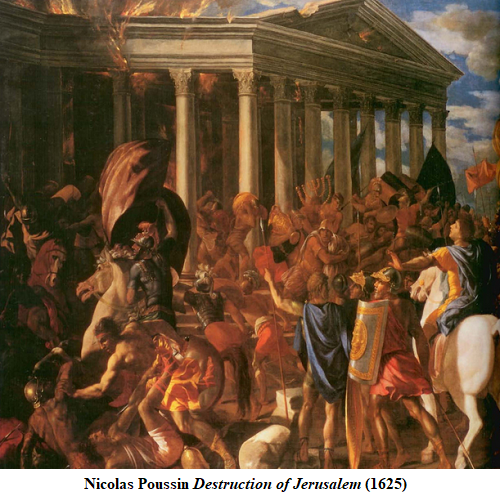
Over the past century, several incredible archaeological and manuscript discoveries were made near the Dead Sea, at Nag Hammadi in Egypt, and elsewhere. They provide vital information that supplies crucial missing parts of the great jigsaw of Ancient history. However, in order to be properly understood and assessed they need to be seen in the context of the three Jewish wars that tore the Eastern Mediterranean world apart between 65 and 135 AD.
Mystery, myth and legend surround the second and third of these horrendous conflicts, and historians have always struggled to piece together what were virtually genocidal wars that left few records. Fortunately however, a detailed narrative of the first war can be derived from the eye-witness histories of the great Jewish historian, Josephus – The Jewish War and Jewish Antiquities – and by other contemporary accounts. Taken together with archaeological evidence, these vividly illuminate the spiritual crisis and apocalyptic worldview (amounting almost to madness) that shaped fundamentally the theology, practices, and self-understanding of Judaism and Christianity in the crucial early decades of their birth.
***
Powder Keg The first Jewish-Roman War began when the Roman procurator of Judaea, Gessius Florus, made a huge mistake. He knew he was sitting on a powder keg; he just didn’t know how explosive it would be, sending him running for his life, ultimately consuming the entire country, and reshaping the religious history of the world. Florus had owed his appointment two years earlier in 64 AD to his wife’s friendship with Poppaea, the ill-fated wife of the Emperor Nero, rather than to any diplomatic skills. He revelled in corruption, gravitated to the pagan Greco-Roman population, and soon found himself in deadly conflict with the most pious of the fiercely monotheistic Jewish people.
Resistance & the Apocalypse Great sections of the Jewish people profoundly resented their political subjugation to Rome and their cultural subjugation to pagan Hellenization. While some were prepared to compromise, accepting the concessions the Romans made to Jewish sensibilities, these moderates lost ground in the middle of the 1st Century AD and the radicals seized the initiative. Increasingly reckless, they looked forward to the End Times and the final showdown between God’s Chosen People and the pagan world led by Rome. In this they were fortified by a pervasive Apocalypticism deeply rooted in the Judaic tradition, as exemplified in the Dead Sea Scrolls. This involved the belief that the End of Days was approaching, that there would be a massive conflagration (perhaps on the historic battlefield of Megiddo – hence ‘Armageddon’), and that out of this terrible turmoil an independent, god-fearing, theocratic Jewish state would emerge.
Forewarning Florus should have known what was coming. Two generations earlier, Judaea had been a client state under Herod the Great, and when he died in 4 BC his realm was divided amongst his sons. One of these was Herod Archelaus, whose cultural and religious ineptitude infuriated the pious and provoked rowdy protests around the Temple. In response, Archelaus sent in his troops, and they slew thousands of protesters, many of whom had come to Jerusalem for the Passover festival. At the following feast of Pentecost, protesters gathered again, many more were slaughtered, and there was general destruction. Rebel bands formed in the countryside, including one led by Judas of Galilee, which captured Sepphoris, not far from Nazareth, where Jesus, the young son of a carpenter, was growing up. Judas led resistance to the census imposed for tax purposes by the Romans in 6 AD, attacking those Jews who registered, burning and their homes and confiscating their livestock. He was also the author of the mysterious ‘Fourth Philosophy’, which served as a radical theocratic ideology in the political turmoil to come.
The Many Scandals of the Dead Sea Scrolls: parts One and Two
The Romans reacted violently to such rebellions, and Publius Quinctilius Varus, the governor of Syria, marched south, sacked Sepphoris, razed it to the ground, along with numerous other towns, crucified hundreds of rebels, and sold thousands of Jews into slavery. Subsequently, a delegation of leading Jews went to Rome and begged Augustus to abolish the kingship in Judaea. Augustus removed Archelaus and made Judaea a minor Roman province, administered by a procurator responsible to the governor of Syria. This was the position later held by Florus.
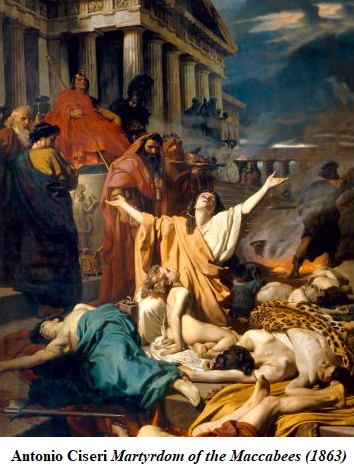
The Abomination of Desolation Rebel activity continued, as did the exemplary Roman policy of crucifixion for rebels and dissidents (claiming the carpenter’s son, on the first Easter). Nationalistic fury and apocalyptic expectations festered, and these threatened to explode forth when the increasingly deranged Roman Emperor, Caligula (r.37-41), became convinced he was a god and ordered the Jerusalem officials to have his statue installed in the Temple. Nothing could be more horrendous to the Jews; they had already compromised their beliefs by agreeing to carry out sacrifices in the name of the Emperor, but they couldn’t countenance a graven image of a pagan demi-god in their Temple. This would be the ‘Abomination of Desolation’, the demonic sacrilege foretold in the apocalyptic Book of Daniel and echoed in the New Testament, and reaction was immediate: thousands of Jews went directly to the governor of Syria and begged to be executed then and there in cold blood so that they didn’t have to witness Caligula’s edict being carried out. The shadow of an all-consuming conflagration loomed over Judaea until the situation was eased by Caligula’s assassination. Nevertheless, the final countdown had begun.
Division Despite the repeated provocations, effective Jewish resistance to Rome was crippled by division and sectarianism. Despite their shared monotheism, the Jews were divided by political, religious, and class conflicts: Sadducees, Pharisees, Zealots, Hellenes, anti-Hellenes, rich and poor, pro-Rome and anti-Rome. And some of these rivalries were murderous; indeed the Sicarii – the extremist wing of the Zealots – practiced systematic assassination, murdering Gentiles and Hellenised Jews in the streets before melting away into the crowd. In addition, the city population was swollen by idle peasants and unemployed and resentful workers. These added to ‘the people of the land’ – the masses of common folk looked down upon by the religious elites as the “accursed” (John 7:49). On top of that, there was the centuries-old antagonism between the Jews and the Greeks, found in every city in the Eastern Mediterranean, and that had recently flared into violence in Caesarea. There was also outrage at the judicial murder of James the Just, the widely respected leader of the main faction of the nascent Jesus Movement, founded some 30 years earlier by his brother.
Eye Witness Josephus has left an eye-witness account of the situation upon his return to Jerusalem after a journey to Rome: “I found revolutionary movements already begun and great excitement at the prospect of revolt from Rome.” He tried to alert the Jewish radicals of the enormous folly of what they were about to attempt, but “I did not persuade them. The great insanity of those desperate men prevailed.”
Provocation Notoriously corrupt, Florus (left) had confiscated funds from the Temple, the centre of the Jewish 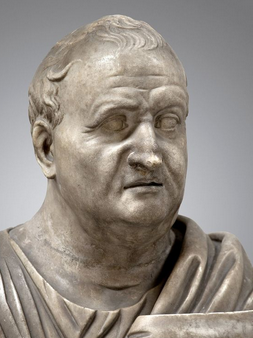 faith. The devout Jewish masses rose up in fury and Florus mobilized a large military contingent in a show of force, demanding that the people demonstrate their loyalty to Rome by going out in procession to greet the troops. Instead, they made their hatred obvious, shouting abuse at Florus and provoking the troops into a violent reaction. The soldiers fell upon the protesters and invaded their homes, flailing about with clubs while the cavalry trampled terrified men, women, and children under hoof. Hundreds were suffocated and crushed around the city gates as they struggled to escape, their bodies mangled beyond recognition.
faith. The devout Jewish masses rose up in fury and Florus mobilized a large military contingent in a show of force, demanding that the people demonstrate their loyalty to Rome by going out in procession to greet the troops. Instead, they made their hatred obvious, shouting abuse at Florus and provoking the troops into a violent reaction. The soldiers fell upon the protesters and invaded their homes, flailing about with clubs while the cavalry trampled terrified men, women, and children under hoof. Hundreds were suffocated and crushed around the city gates as they struggled to escape, their bodies mangled beyond recognition.
Polarisation Jewish moderates in the city tried desperately to stem the rioting before it escalated into open revolt. They were led by Agrippa II, a puppet ruler who had oversight of the Temple and religious affairs (and who heard the case in 60 AD of a certain Paul of Tarsus who led another faction of the Jesus Movement and had recently been put to death in Rome). Agrippa (right) had been educated at the court of the Emperor Claudius 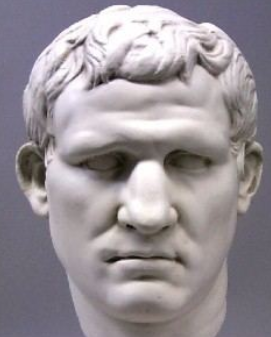 and remained a steadfast Roman loyalist. He addressed the Jews and urged that they accept any temporary injustices and submit to Roman imperial rule, as the alternative could be annihilation. His plea failed and the city population polarised further behind either the war party or the peace party.
and remained a steadfast Roman loyalist. He addressed the Jews and urged that they accept any temporary injustices and submit to Roman imperial rule, as the alternative could be annihilation. His plea failed and the city population polarised further behind either the war party or the peace party.
Quite apart from war with Rome, Jerusalem was also facing class warfare: the pro-peace High Priest was assassinated, while the City Treasurer and two colleagues were condemned as pro-Roman “traitors to our common liberty,” and had their throats cut by the Zealots. Meanwhile, the luxurious town houses of the pro-peace city elite were sacked and set on fire, as were the Public Archives where all records of borrowings and money-lender debt were lodged.
Betrayal Elsewhere, a small Roman force that had tried to keep the peace found itself cornered and besieged by a furious mob. Promised safe passage out of the city if they surrendered their weapons, the soldiers did so, but were double-crossed and all 600 were massacred, vainly protesting as they died: “But we had an agreement!” The Jewish militants rejoiced, but many more Jerusalem Jews were filled with dread as they contemplated the reaction of Rome to this outrage.
Reticence The initial response was led by Cestius Gallus, the legate of Syria, who brought in the Syrian legions, reinforced by auxiliary troops, to quell the revolt. Arriving at Jerusalem after devastating the countryside, they advanced into the city suburbs and prepared to besiege the inner city and the Temple, the monumental edifice renovated and expanded at enormous cost by Herod the Great, nearly a century before. But first they offered terms to the rebels: they would be pardoned if they laid down their weapons and confirmed their allegiance to Rome. The rebels responded with ridicule and violence, even killing one of the peace emissaries. The Army then set about the siege, systematically undermining the walls and gates protecting the Temple. Inside, the defenders began to panic and talk of a last-minute surrender. But then Cestius called a halt and began to retire from the city. To this day nobody knows why, but it could be that he was reluctant to storm, violate and destroy one of the greatest buildings in the Empire.
Massacre His reward was quick in coming: as he attempted to retreat to the coast the rebels mobilized their own forces and fell upon the hapless Romans. Eventually, almost the entire Roman Army was wiped out, over 5000 men, while vast amounts of weaponry and military machinery were seized by the Jewish rebels. Once again the militants were joyous, while the few remaining moderates fled Jerusalem. Finally it was clear: Rome could not countenance such rebellion and humiliation, and the Jews would now face the full force of the mighty Roman military machine, a force that had carried all before it for centuries and conquered much of the known world.
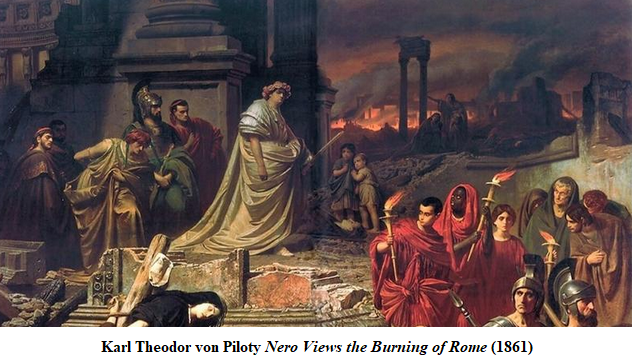
Bravado The Emperor Nero put the matter into the hands of the veteran general Titus Flavius Vespasianus, with his son Titus as his second in command. Through 67 and into 68 AD a massive Roman force was gathered, totalling over 60,000 troops, while all the countryside around Jerusalem was remorselessly pacified, driving thousands of traumatised peasants into the Holy City. They were eager to warn of the ferocity of the force bearing down on all of them, but the rebels wouldn’t listen; they were full of bravado after their massacre of Cestius’s retreating army. Moreover, it seemed Rome herself was in disarray: Nero had been overthrown and driven to suicide, several subsequent Emperors had come and gone, and eventually Vespasianus ascended to the throne, as Emperor Vespasian. Inevitably there was a pause in hostilities as his son, Titus, assumed command and began to plan a monumental military campaign that would bring victory and glory to him and his father.
Year One Meanwhile, the rebels had set up a provisional government and proclaimed a new era, complete with their own coinage. These were stamped: ‘Year One’, ‘Year Two’, etc., and marked with slogans declaring: ‘Jerusalem is Holy’, ‘Freedom of Zion’, and ‘For the Redemption of Zion’. They believed they had seen off the Romans and were now living in an independent Jewish state centred on the Temple, whose watchwords were Freedom and Holiness.
Factions The new revolutionary Jewish state was relatively untroubled by the Romans from 68 into early 70 AD, and so the citizens of Jerusalem fell back into self-destructive factional infighting, now made all the more violent by the ready availability of the weapons taken from the Romans. Central to this fratricidal fanaticism were the Zealots: assisted by radical junior priests and supported by masses of fundamentalist Jewish peasants flooding into the city, they began to murder the remaining moderates and the wealthier residents of the Holy City.
Escapes Around this time, the decision may have been made by the Temple authorities and Jerusalem scholars to take their precious library and hide it in the caves in the vicinity of Qumran, 45 km away. Alternatively, it may have been the sectarian library of Qumran itself that the community there decided to hide in the caves as the Romans advanced. Either way, it would be nearly 19 centuries before these precious documents would once again see the light of day. Meanwhile, members of the new Jesus Movement decided it was best to leave the Holy City. Somewhere amongst them may have been the scholar known to history as ‘Mark’, the writer of the first Christian Gospel.
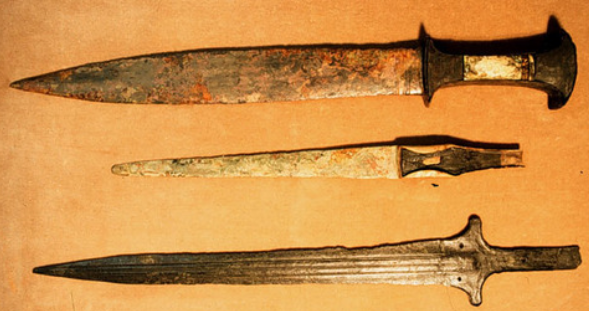
To Masada Another group to escape were the Sicarii, a name drawn from their weapon of choice (above). The terroristic cult had made a grab for power in Jerusalem in 68 AD and had then fled to Masada, the impregnable palace and fortress complex atop a mesa near the Dead Sea. There they butchered the small Roman garrison, survived through banditry, and fortified themselves for the long siege they would face. It would be 73 AD before the Romans systematically stormed the hilltop fortress, only to find the bodies of 960 men, women, and children, dead by their own hands, establishing a model of militant martyrdom that survives to this day.
The Fourth Beast It was also around this time that the great Jewish sage Yohanan ben Zakkai escaped from Jerusalem. He had campaigned against the war with the Romans, arguing that the Empire was the mighty ‘Fourth Beast’ prophesied in the Book of Daniel, Ch.7. He invoked the Prophet to stress how Rome was “different from all the other [empires] and most terrifying; with its iron teeth and bronze claws [it] crushed and devoured its victims and trampled underfoot whatever was left”; and how its immense power would prevail “until the Ancient of Days came and pronounced judgment in favour of the holy people of the Most High, and the time came when they possessed the Kingdom.”
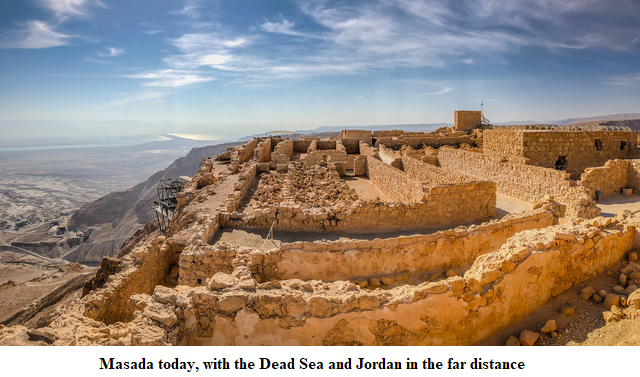
To Yavne However, the apocalyptic mentality had taken hold of the Jews and Yohanan found his countrymen delirious with the conviction they could win. Despairing, he posed as a corpse inside a coffin and was carried out of the city to the Roman camp. There he was granted an audience with Vespasian, who approved his request to be allowed to travel to Yavne, a small coastal town, and resume his religious teaching. Initially this involved a small study group that met in the upper storey of a house. Later, after the complete destruction of Jerusalem, this school attracted Rabban Gamaliel II, the grandson of Gamaliel, the great scholar who had been the teacher of Saul of Tarsus, who would become St Paul. The school became a centre for Jewish scholars as they wrestled with the dilemma of how Judaism could survive without the Temple. In this fashion, Yohanan ben Zakkai played a central role in the reconstruction of Judaism as a ‘Religion of the Book’; and so it was at Yavne that the foundations of Rabbinic Judaism were forged.
Zealots Meanwhile, Jerusalem had divided up into three antagonistic zones, patrolled by their own militias led by their own commanders, and engaged in internecine fighting, treachery, betrayal and arson. And soon it was just two factions, as the Zealots seized control of the Temple. There they were besieged by the moderates, led by a leader of the Provisional Government and former High Priest, Ananus ben Ananus. The Zealots falsely accused Ananus of collaboration with the Romans and mobilized sufficient support to have him and the moderates slaughtered.
The Zealots then had effective control of the city and continued their purge of those they suspected of favouring a peaceful resolution. It was only the final onslaught of the Roman Army that forced the warring parties into some semblance of an alliance. But this was not before these factions had destroyed the city’s food supply in an act of fratricidal insanity.

Onslaught The scale of the Roman onslaught, in Spring 70 AD, was stupefying. Another legion had been added to the existing Roman Army along with contingents sent by their allies. Suddenly, Jerusalem was surrounded by one of the biggest armies ever to mount a siege in ancient times, and it was there to stay until the city either surrendered or starved to death. Hemmed in by trenches, stone wars and guards, nobody could enter or leave, and those caught trying to escape were crucified in full view of the city. After a time, the bored soldiers began to amuse themselves by nailing up the victims in various novel positions.
The Full Horror After a few months the common citizens were starving, and the full horror began., Josephus has left an eye-witness account of the destruction of Jerusalem in The Jewish Wars, and he recorded vividly the appalling effects of the siege, as people sold everything they owned for a few handfuls of grain and then wolfed them down uncooked or began to dig up and eat any grass or weeds they could find. Next they were gnawing on leather belts and sandals, and even eating dung and “objects that even the filthiest of brute beasts would reject.” Thousands of bodies were littering the streets and there were appalling reports of cannibalism, too ghastly to recount here.
Demolition But then Titus changed strategy; the war had been going on too long and a quick victory now suited him and his new imperial father, Vespasian. Outer suburbs were quickly razed, while Titus mobilized his vast battery of siege engines – machines specifically designed to destroy a city and terrorize its inhabitants. Soon, huge stones were thumping against the city walls or flying over them to demolish the buildings inside. Giant crossbows were firing massive bolts, and these plunged over the wall to impale the inhabitants, their animals, and wreck their homes. Vast siege towers were moved into place and the troops inside began their demolition work. Sappers undermined the walls, while battering rams smashed into the wooden gates. Soon these were splintered and ablaze, and the city defences were being reduced to rubble. Clearly the end was near.
No Quarter Even at this late stage Titus offered the rebels an opportunity to surrender on terms. His paramount objective was “to preserve the city for himself and the Temple for the city.” Mistakenly taking this for weakness, the rebels counter-attacked and the battle resumed, entering its final horrific phase; it was clear now to both sides that no quarter would be given. After further days of intense street fighting, the Romans hacked their way into the outer precincts of the Temple. This was possibly the greatest religious structure in the world at the time, and Titus gave strict orders to preserve it. However, fire was raging all around and soon the outer court of the Temple was ablaze, and then the inner court was alight. The remaining rebels ran for their lives, while the last priests flung themselves into the flames rather than surrender to the pagan Romans.
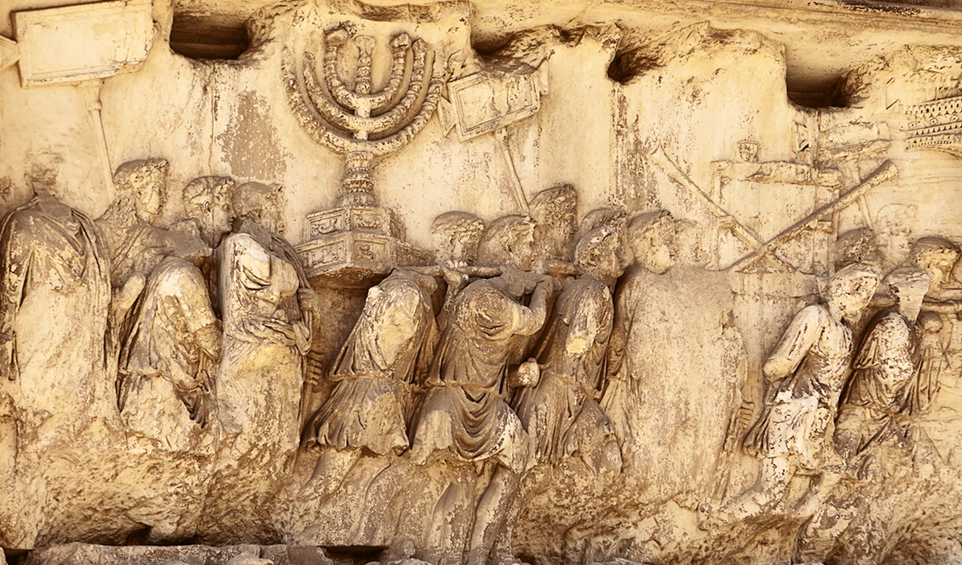
Defilement & Triumph For centuries, the sanctity of the Temple had been carefully preserved, and any non-Jew who entered was instantly put to death. But now the Roman troops charged into its very heart, rampaging through the Sanctuary, defiling the Holy of Holies, plundering everything they could find, and slaughtering everyone they came across. The Romans looted the treasury, seized the priceless gold furniture, the golden trumpets, and the massive, seven-branched gold Menorah. The design of this had been revealed by God to Moses (Exodus 25:31–40), but now it was simply war booty, taken to Rome and exhibited during the triumphal festival staged in honour of Vespasian and Titus (It later disappeared forever during the Sack of Rome in 455 AD).
Violation Titus and his retinue also violated the Holy of Holies, where the Ark of the Covenant was kept, and infamously taunted the Jewish God. It seemed to the victors that the pagan gods of Rome had won a great victory over the One God of the Jews.
Merciless As Herod’s glorious Temple burned, the sack of Jerusalem began in earnest. In compensation for the vicious hand-to-hand street fighting they’d had to endure, the troops were given free rein to kill, loot and pillage the Holy City: “No pity was shown for age, no reverence for rank; children and greybeards, laity and priests alike were massacred; every class was hunted down and swallowed up by the jaws of war,” as Josephus records.
Everywhere there was deafening noise as the flames consumed the buildings, the Roman soldiers yelled out in victory, their victims screamed in agony, and the common folk wailed and howled in disbelief at the horror that was engulfing them. In the end the city capitulated totally and was then razed, leaving smoking ruins and the stench of death. Well over 100,000 people died in the war (contemporary accounts say 1,100,000!). Tragically, this included many who died in the murderous factional disputes that were endemic amongst the Jews and crippled their capacity effectively to resist. A further 97,000 were captured and enslaved. Later visitors to the city had trouble even believing how anyone had ever lived there.
The End of Temple Judaism And so also died the Temple, the one great sacred holy place where the God of the Jews could be worshipped and propitiated with solemn sacrifices and strictly regulated rituals; and with its loss was excised the very heart of Judaism as it had been practiced from time immemorial. Shockwaves reverberated violently through every aspect of Jewish life and culture. The Sadducees, the Essenes, the Zealots, and the Sicarii virtually disappeared from history, with only the Pharisees left of all the factions that had shaped Jewish history for the previous two centuries and brought it to this ignominious climax. One ominous question looked large for anxious Jewish scholars: surely these were the End Times, and yet, in the midst of all this carnage and destruction, where was the God of the Jews?

Phoenix But out of the ashes, new religious movements emerged phoenix-like, as the Jewish people and others struggled to make sense of what had just happened. A radically new Judaism was laboriously constructed; and a new monotheism continued its complex development into Christianity, centred on the tale of the obscure son of a Galilean carpenter and the meaning of his death by crucifixion decades before upon the first Easter. And shadowing these there was another spiritual phenomenon: an obscure religious movement, a nihilistic mood, a belief that the path of escape from all human striving and suffering could be derived from a special esoteric knowledge – gnosis – that was embedded in cosmic myths, the nature and origins of which are only now being understood in the light of discoveries at Nag Hammadi and elsewhere.
***
Aftermath When the First Jewish–Roman War broke out, it reflected various factors: the incompetence of the Roman governors and the general oppressiveness of Roman rule, acute Jewish religious sensibilities, chronic sectarianism, class tensions that defied resolution, perennial quarrels with gentiles, resentment of intrusive Hellenization, and growing factionalism and social disunity. After its catastrophic conclusion the ancient Jewish religion was left decapitated; without its Temple, and reeling from the trauma, Judaism was forced to gradually reshape itself into the Rabbinic form it has had ever since.
The Kitos War (AD 115–117) But the lesson wasn’t learned, and the warning of Yohanan ben Zakkai that the Roman Empire was the all-devouring ‘Fourth Beast’ went unheeded. And so, another widespread rebellion occurred, this time within the Jewish diaspora, swollen by refugees from the First War. It arose out of the long-standing mutual hatred between the Jews and the Greeks around the Eastern Mediterranean and North Africa. It began under the reign of the Emperor Trajan, while he was pre-occupied with a massive campaign against the Parthian Empire in the East.
Taking advantage of this, the Jews launched coordinated attacks on Roman forces and the Greek populations in Alexandria, Cyrenaica (Libya), Cyprus, and elsewhere. Roman and Greek temples and innumerable civic buildings were systematically destroyed. In retaliation, the Jewish population of Alexandria (who had helped found the city centuries before) was exterminated, as was the Jewish population of Cyprus, from where Jews were henceforth banned upon threat of death. Hideous atrocities were reported, reflecting the intensity of the mutual hatred, and the casualties were enormous: at least 500,000 died and some regions were left totally depopulated.
The Bar Kokhba Revolt (AD 132–136) But even this was not the end. There was one final war to come, and this unfolded on an unprecedented scale under the reign of the Emperor Hadrian. It was fueled by the religious and political tensions in Judaea that had festered since the destruction of Jerusalem, and it was triggered by several highly inflammatory decisions taken by Rome: (1) a ban on circumcision, which the Romans regarded as grotesque mutilation, but which the Jews considered amounted to a ban on Judaism itself; (2) the realization that the Romans were never going to allow the rebuilding of the Temple, historically the keystone of Judaism; (3) a decision by Hadrian to rebuild Jerusalem as a new pagan city named after himself; and, (4) a direction to construct a new pagan temple to Jupiter in this new city, right on the Temple Mount where the Holy of Holies had previously stood.

Messiah? The revolt was led by Simon bar Koseva, who was recognized by Jewish leaders as the long-awaited Messiah, and given the title ‘bar Kokhba’, meaning ‘Son of the Star’. This gave vital religious legitimacy to what came to be seen as an apocalyptic war for either the liberation or death of the Jewish faithful. The rebels avoided pitched battles, preferring a terroristic guerilla campaign, and they established an independent state of Israel that survived for over two years with Simon as prince. Once again exasperated by the intransigence and militancy of the Jews, the Romans brought in a massive force of its elite, battle-hardened legions from as far away as Briton, and resorted to a war of extermination. Inevitably, the Jews were utterly defeated: some 580,000 died in the fighting, innumerable others died from hunger and disease, and many more were sold into slavery. The Romans instituted a policy of ethnic cleansing, driving the entire Jewish population out of Judaea. They then renamed the region Syria Palestina, and the land of Judaea, name after its people, simply ceased to exist. Revolts were not uncommon in the provinces of the Empire, but never before or after was such a drastic measure taken. In their profound disappointment, subsequent Rabbinical scholars designated Simon ‘bar Koziba’, meaning, ‘Son of the Lie’.
Shaping World History And so, in less than 70 tragic years, the apocalyptic and revolutionary fervor of the Zealots, Sicarii, and other militant Jews had brought ruin upon their own people, land, culture, and religion. With the Temple destroyed, the very heart of their faith had been ripped out. Landless and leaderless, Judaism was forced onto a new path, orientated around the rabbis and their holy texts. Forced to exist as a nomadic diaspora living in other people’s lands, the Jews suffered centuries of persecution and near extinction, and it would be over 1800 years before they would once again claim a homeland.
Meanwhile, the great Abrahamic monotheistic tradition began to mutate, ultimately into three great religions, Judaism, Christianity, and Islam, fundamentally shaping the history of the world. Serendipitously it seems, the discovery in the mid-20th Century of the Dead Sea Scrolls and the Nag Hammadi Library opens up an unprecedented portal into the complex unfolding of these incredible events.
 Sign In
Sign In 0 Items (
0 Items ( Search
Search










I found myself constantly using Google Earth to grasp the nuanced detail of the geography inherent in this fine essay – so much so, that on re-reading the essay, I just kept GE open on the screen.
Thanks Mervyn for reminding us that man’s inhumanity to man is indeed timeless – particularly when partnered with religious “certainty”.
A great series of articles culminating in this fascinating history.
One small correction: the (not so) obscure carpenter’s son was resurrected on the first Easter, not crucified. Had it been merely the latter his story would have ended there and remained truly obscure.
Mervyn, some important details were omitted. The reason the Jesus Movement flourished and we celebrate Easter today is because Jesus came back from the dead after being crucified, just as he predicted he would (which is all rather difficult to arrange — unless you actually happen to be God). You mention that the members of the Jesus Movement vacated the Holy City before it was destroyed. No doubt with the resurrection and ascension of Jesus in living memory they would have taken very seriously his prediction that the temple would be totally destroyed.
They were simply following his reliable advice. Not even the mighty Titus could overrule the pronouncements of Jesus.
Thanks Mervyn. I enjoyed reading it and have Josephus’s ‘The Jewish War’ transalated by G.A. Williamson’s and have read it many times always intending to get his ‘Antiquities of the Jews’, ‘Life’, and ‘Against Apion’ which I read tell us a little more of that little known time. It’s pretty hard to get ones mind around the enormity of the destruction and death and to imagine the ferocity of the hand to hand fighting. Vespasian was a real fighting Roman General of course, as was his son Titus and Josephus was without doubt the best Commander among the Jews, but the fanatics among them, refusing to negotiate and come to terms sealed their fate, convinced Josephus that their self destruction was pointless and his only option was to talk to join Vespasian. The prophesy of our Lord Jesus therefore came to pass and his warnings and future signs were remembered by the Christians and carried out : I read that before the City was encompassed they fled to Pella, and so escaped the general destruction.
interesting.
How much are you relying on Josephus though? His work was pure propaganda, written to make his Roman overlords look good.
The Jesus Movement? Seriously?
Christianity came into being on the third day, and was expressed a few days later by Thomas the sceptic; “My Lord and my God.” By the time of Paul’s letter to the Galatians, Jewish Christianity’s embrace of the Gentiles was well established; so much so that Paul berates Peter for separating himself from the Gentiles to eat with “circumcision party.” This happened in Antioch, the city in which followers of The Way (as it was initially know) were first called Christians. Yet it was Peter who first preached that the Gentiles had been admitted. Peter’s social embarrassment would be resolved, and the “faction” that demanded circumcision would have its universalist ambitions dashed, in Jerusalem within a year or so.
Christianity has a valid claim to being the divinely-inspired continuation and elaboration of the the religion of the Passover. While Christianity was expanding around the Mediterranean, the scholarly remnants of the mutually destructive factions of the old worship – as you have illustrated – struggled to cobble together a new “mutation,” standardising the texts as they went.
Christianity has its mutually destructive factions, to be sure. Christianity has its papered-over doctrinal lacunae. But Christianity’s story and claims are the best documented of the ancient world, and the line is unbroken.
If you wish to call second-century Rabbinical Judaism as a mutation, I’m not going to argue with you. But if you call Islam also a mutation, no-one will be happy, least of all Muslims, who regard Judaism and Christianity as mutations of Islam.
A great read as others have already commented. However, on this last point, I beg to differ:
Following pbw, I would suggest that Islam is a reactionary heresy of the Judeo-Christian mainstream. And the Muslim claim of the reverse is chronologically unsustainable – the Prophet Muhammad was born in about 570AD, by which time the Christian faith had already gone through five major Councils dealing with significant theological problems.
There is no doubt that all three have fundamentally shaped world history, but “mutate” is probably not a word I would use to describe their history.
I love history not because I am an historian but I like to know how we got to where we are. There are a handful of names from the past that most people are familiar with and with one exception they were all generals or rulers of empires. The exception was a quiet unassuming man who began a movement based not on military might and power but on a simple rule; love God and love your neighbour. That movement has lasted two millennium, has seen it’s adherents persecuted and ridiculed yet it survives even now when there are so many determined to extinguish it. While we might admire Alexander and Julius they do not inspire billions of people to attend services or provide charitable works. Much of what is considered Western civilization arose from Christian values; your so called Jesus movement. Jesus only has a following because He promised a heavenly reward but more importantly proved with His resurrection that it was a promise He could keep. The unbelievers take Good Friday off and say Jesus was just a man because He died. They ignore the Sunday resurrection because it is too challenging to contemplate if there is no God with unlimited powers.
Absolutely correct Winston. I also have great regard for the theory that the practice displayed in Acts of believers in Jerusalem selling all their possessions to be held in common was in response to the prophecy of the impending destruction of the Temple by Jesus. There was no point owning any property if they were meant to flee the city. The practice of selling all property and holding it in common was not widely practiced by the early Church in areas other than Jerusalem, which lends weight to the theory.
Lawrie, I agree but would also add that they also ignore Pentecost which is the fulfilment of Jesus’ promises to his followers, the gifting of the indwelling Holy Spirit to us here on Earth. I personally would find it hard to practice the religion simply on the basis of a promised future heavenly reward. God’s Kingdom is also here and now and can be directly experienced as an adopted son through the Holy Spirit. The key is hidden in the Lord’s Prayer, which is the formula for unlocking the Holy Spirit in our lives. He is visible in every section of this prayer if you know how to look for Him.
History is written by the victors and Josephus would be no exception. And so much history is now rewritten even in places like Encyclopedia, Brittanica that opinion triumphs over facts. For instance, EB has Josephus born in Jerusalem, Israel when Israel did not exist in concrete form.
Josephus was born in Palestine, which had been under Roman rule since 63BC. The Hebrews/Jews, had wandered into Palestine around 1,000BC, and the ancient Egyptians, who had been talking – inscribing on stone actually – about Palestine and the Palestinians by that time for 2,000 years, also mentioned the arrival of a tribe called Judea. These Hebrew tribes grew in essence, into separate tribal kingdoms, which, with the arrival of the Romans, having already been in decline, were easily subjugated. Such has been the way of the world through thousands of years and certainly in the Middle East, the ‘seat’ of the first civilizations.
The Jewish wars may well have as much credibility as anything Josephus wrote about Jesus, given that he was born some 30 years after Jesus is believed to have died, and any knowledge he had was hearsay.
Not that religious teachings make for history, however relevant they may be for followers of the religions which make use of them.
I see a parallel between ancient Roman ambitions and modern Chinese ambitions.